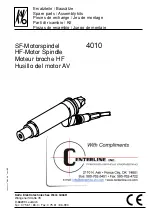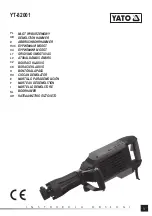
6
ASSEMBLY
WARNING:
Do not connect to power supply until assembly
is complete. Do not use if any parts are missing
or damaged. Failure to comply could result in
accidental starting and possible serious personal
injury.
REMOVING THE BASE
Unplug the router.
Pull the base quick release lever to the open position.
Get a firm grasp of the base with one hand. Hold the
top of the router with the other.
Pull the motor housing away from the base until they
separate.
To
re
connect the motor housing to the base:
Align the motor housing rack gears with the pinion gears
on the base and push the motor housing onto the base.
Close the quick release lever.
WARNING:
If you are changing a cutter immediately after
use, do not touch the SpeedMill™, collet nut,
cutter, or collet with your hands or fingers as
they may be very hot. Always use a wrench to
avoid getting burned.
INSTALLING AND REMOVING SPEEDMILL™
Read your Easy Jig® manual for complete directions.
Unplug the router.
Pull the base quick release lever to the open position.
Remove the base to provide clear access to the collet
nut.
Depress the spindle lock button and rotate spindle
until the spindle locks.
Rotate the wrench counterclockwise to loosen the
collet nut. (See Figure 2)
Remove collet nut and collet from the spindle.
Screw a #3C 80 Percent Arms SpeedMill™ onto the
spindle. Securely tighten the SpeedMill™ by turning
it clockwise with a wrench.
Do not remove the protective end mill tip cover until
ready to start milling.
Push the base quick release lever to the closed
position.
WARNING:
If the SpeedMill™ or collet nut is not tightened
securely, the cutter could come out during
milling, resulting in property damage and
possible serious personal injury. A collet and
collet nut are not used when using a SpeedMill™.
REMOVING THE SUBBASE
See Figure 3
Unplug the router.
Turn the router upside down to unscrew the
subbase screws.
Remove the subbase.
NOTICE
:
The Subbase must be removed before using the
router with an Easy-Jig® Gen 2-3 Router Adapter
Plate. Please see Easy-Jig® manual for details.
ADJUSTING T
OOL BASE LOCKING LEVER
1
2
3
4
5
6
To check function of the quick release Locking Lever (4),
unlatch the lever and move the Tool Base (2) up and down
by turning the Adjusting Screw (5). Close the Locking
Lever to secure the Tool Base. Grasp the motor housing
and firmly pull and press on the Tool Base to make sure it
is secure and it does not slip. If the Tool Base is not secure
with the Locker Lever latch closed, adjust the Tension Hex
Nut (6) until the Tool Base is secure and does not slip when
pressure is applied to the Tool Base.
Do not tighten the Tension Hex Nut more than 1/8th of a
turn at a time before rechecking if the Tool Base is secure
and does not slip. Periodically check that the Tool Base is
secure to prevent the Tool Base from slipping during
milling.
1.
Bit Protrusion
2.
Tool Base
3.
Depth Scale
4.
Locking Lever
5.
Adjusting Screw
6.
Tension Hex Nut
CAUTION
:
Do not bottom out or tighten the Tension Hex Nut
more than needed to avoid damage to the latch
mechanism. Failure to properly adjust the Locking
Lever Tension Hex Nut can result in property
damage and personal injury.






























